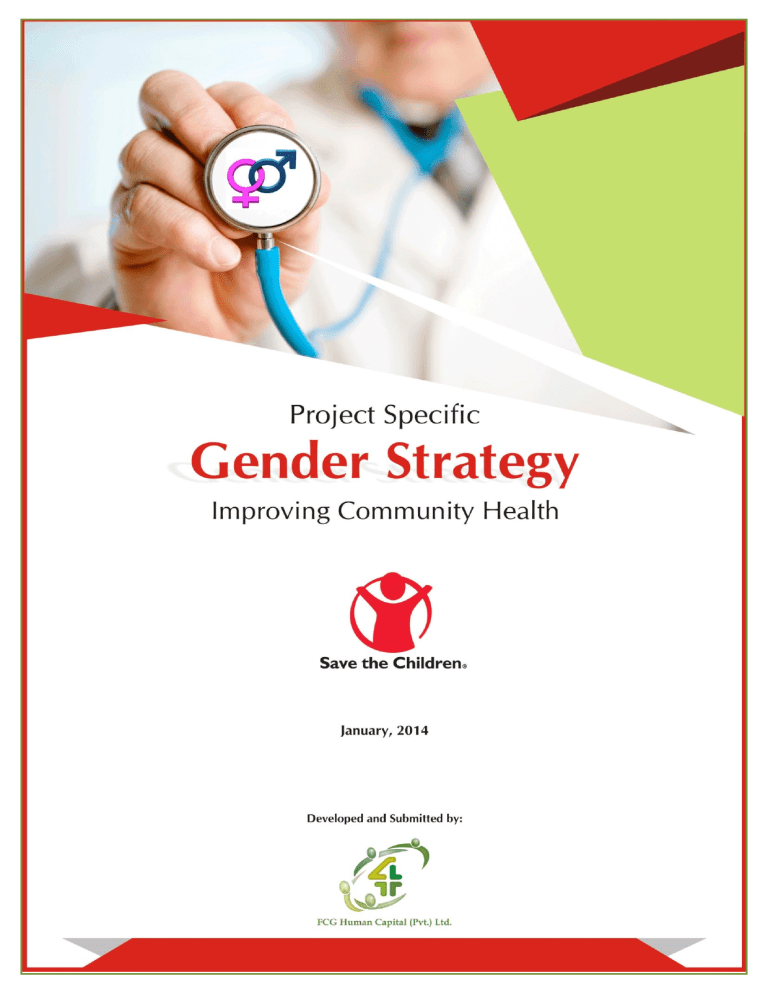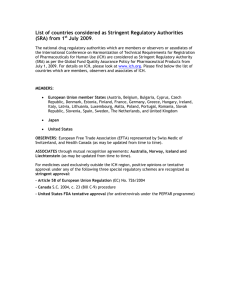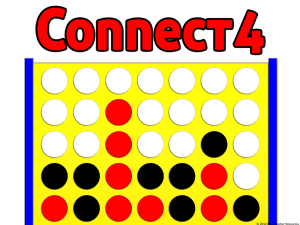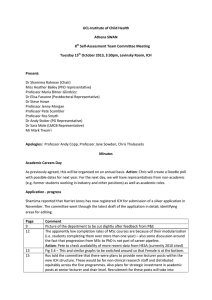
GENDER EQUIALITY ACTION PLAN IMPROVING COMMUNITY HEALTH (ICH) PROJECT PERIOD COVERING 01 JANUARY, 2014 TO JANUARY 2016 GENDER EQUIALITY ACTION PLAN IMPROVING COMMUNITY HEALTH (ICH) PROJECT PERIOD COVERING 01 JANUARY, 2014 TO JANUARY 2016 ACKNOWLEDGEMENT FCG HUMAN CAPITAL (FCGHC), PART OF FOUR CORNERS GROUP (FCG) PRIVATE LIMITED, WAS COMMISSIOED BY SAVE THE CHILDREN (STC) TO DEVELOP GENDER MAINSTREAMING STRTEGY FOR THE PROJECT, IMPROVINGCOMMUNITY HEALTH, IMPLEMENTED IN BALOCHISTAN AND KHYBER PAKHTUN KHWA (KPK). FCGHC TEAM WISHES TO THANK STC STAFF IN ISLAMABADAD, QUETTA AND PESHAWAR FOR FACILITATING THE GROUND WORK FOR THIS ASSIGNMENT CARRIED OUT JOINTLY BY: SHADAB FARIDUDDIN, LEAD CONSULTANT, STRATEGY & ORGANIZATIONAL DEVELOPMENT SPECIALIST SHAHZAD BUKHARI, GENDER SPECIALIST AND COO TAHIR IQBAL, QUALITATIVE RESEARCHER AND SENIOR MANAGER KARACHI DECEMBER 2013 GENDER EQUIALITY ACTION PLAN IMPROVING COMMUNITY HEALTH (ICH) PROJECT PERIOD COVERING 01 JANUARY, 2014 TO JANUARY 2016 CONTENTS Abbreviations 1 2 3 03 Introduction 1.1 Purpose and Scope of ICH Gender Strategy 04 1.2 SCI’s Organizational Commitment to Gender 04 1.3 Analyzing Gender in the Context of Project Outcomes 04 Gender Assessment of ICH Project 05 2.1 Roles and Norms regarding Health 05 2.2 Capacity 05 2.3 Control 06 2.4 Practices and Participation 06 2.5 Access (Resources, Services, Information, Benefits) 06 Strategy 06 3.1 Addressing Gender in Need Assessment 06 3.2 Addressing Gender in Project Activities 07 3.3 Addressing Gender in Project Outcomes 07 3.4 Enabling Structures, Resources and Processes 07 4 Goals and Objectives of ICH Gender Strategy 09 5 Gender Equality Action Plan 10 6 Annexure 13 GENDER EQUIALITY ACTION PLAN IMPROVING COMMUNITY HEALTH (ICH) PROJECT PERIOD COVERING 01 JANUARY, 2014 TO JANUARY 2016 ABBRIVATIONS CD Country Director CB Capacity Building CMD Communication Department DHs Department Heads ESMT Executive Senior Management Team GA Gender Advisor GE Gender Equality GFPs GM PDMs Gender Focal Persons Gender Mainstreaming Project Directors and Manager PDs Provincial Directors SMT Senior Management Team GENDER EQUIALITY ACTION PLAN IMPROVING COMMUNITY HEALTH (ICH) PROJECT PERIOD COVERING 01 JANUARY, 2014 TO JANUARY 2016 1. Introduction Gender refers to the socially constructed roles, behaviors, engagements and attributes that human society considers appropriate for men and women, girls and boys. It is believed that each gender should have equal access to information, opportunity to participate in decision making and have control over available resources. However, there is difference between gender equality and equity. Gender equality means that either sex is not routinely privileged or prioritized over other; that is when women and men, girls and boys have equal rights, obligations and chances to move forward and enjoy facilities. Gender equity means being just towards men and women, and girls and boys. It also differentiates their physiological and biological needs and experiences. Gender equality is a fundamental right for all women and men, girls and boys and this notion integrates gender in the work to ensure that activities have the greatest possible impact on children. The integration of gender supports uphold the principles of ‘do no harm’. The gender equality can be achieved if gender specific projects are initiated to mainstream gender approaches through activities. Moreover, there is need to ensure that every child’s equal right to the highest possible standards of health can be fulfilled, but this requires an enabling supportive environment where all community members can access health service, care and information they need. Journey towards gender equality begins with being aware and sensitive towards it. There is also another concept, gender sensitive which means that different needs, abilities and opportunities of boys and girls and men and women are identified, considered and accounted for in decisions by family, community, and society as a whole. Gender sensitivity is one end of the spectrum of approaches. Being sensitive alone seldom results in action. Often radical steps are needed to break the resistance to change. Gender transformative refers to when we utilize a gender sensitive approach and promote gender equality, while working with key stakeholders to identify the root causes of gender inequality for women and men, girls and boys and address it accordingly. STC (Save the Children, International) strives towards gender transformation. It holds the notion that gender equality can be achieved by creating project specific gender strategies that can effectively mainstream gender approaches throughout the activities. 1.1 Purpose and Scope of ICH Gender Strategy According to SCI (Save the Children International), gender equality ensures that either sex has no kind of privilege over other: the opportunities and access to resources are on the basis of competencies, merits and performances. The ICH Gender Strategy will ensure that health benefits are extended to both girls and boys by addressing gender inequalities that exist for each sex, particularly girls and women, in the target community of Khyber Pakhtoonkha. 1.1.1 SCI’s Organizational Commitment to Gender SCI has a clear policy on its commitment to gender equality. It recognizes the need for strengthening and developing organizational culture where there is equal opportunity to influence decision making, gender sensitive approaches, including communication, are being applied, and capacities are being built as they relate to mainstreaming gender in development and humanitarian projects to achieve its mission and objectives in an equitable manner. SCI expresses the need to develop systems and structures that together create an enabling environment to promote gender within its organization as well as implementing partner and beneficiary communities. The intent and commitment is visible at the senior management level and needs to distill downwards in the form of gender sensitive initiatives and monitoring mechanisms which ensure that all segments of the target population are benefitted equally. GENDER EQUIALITY ACTION PLAN IMPROVING COMMUNITY HEALTH (ICH) PROJECT PERIOD COVERING 01 JANUARY, 2014 TO JANUARY 2016 1.1.2 Analyzing Gender in the Context of Project Outcomes In Khyber Pakhtunkhwa, culturally, most health decisions are made by men. However, they often do not have the understanding or willingness to take care of maternal health issues. Mere gender sensitive approach in health and education is least likely to achieve project outcome. So there is need an approach based on gender transformation to identify the main causes of gender inequality and efforts can be made to give equal access to opportunities, resources and in decision making according to physiological and biological needs. The proposed gender strategy for ICH project is aimed at promoting a mix of gender sensitive and transformative approaches towards achieving the project outcomes. 2. Gender Assessment of ICH Project Gender assessment of ICH project reveals major issues that need to be addressed by the proposed intervention under the strategy. This section highlights those issues followed by an explanation, which forms the basis of conclusion reached. 1.2 Roles and Norms regarding Health Execution of gender sensitivity and mainstreaming trainings for the target group affected due to lack of support from the community. Immense need for activities aimed at changing existing norms and roles regarding health in the community. Gender inequality is quite evident within the health sector, especially as it relates to healthy practices and health seeking behaviour in Khyber Pakhtoonkhwa province. Both men and women are provided with nutrition differently. Girls often obtain food which is less nutritious as compared to the one that is given to boys and men. Women also commonly utilize less health services and even care at home is not necessarily available to them. Such discrimination is even more compounded due to poverty issues as less income means that even lesser is available for the girl and women, prevailing cultural norms which grant the ultimate superiority to men because they are primary and lack of education which is probably the most important root cause for the issues mentioned earlier. Such issues were only highlighted and behavioral change communication strategies were used to challenge and change the roles and norms regarding access to health. 1.3 Capacity Gaps Minimal gender mainstreaming capacity assessment and minimum capacity building interventions executed aiming at gender mainstreaming for health. Due to lack of resources and opportunities, the target community is not aware of the gender mainstreaming concepts. The ICH project developed participation and sensitization training as one of the project activities but due to security issues, it was not executed. This also indicates that at the time of project planning, environmental constraints and threats were not considered. Similarly, staff training for gender mainstreaming is also planned but even after 70% completion of the ICH project, the staff has not GENDER EQUIALITY ACTION PLAN IMPROVING COMMUNITY HEALTH (ICH) PROJECT PERIOD COVERING 01 JANUARY, 2014 TO JANUARY 2016 received this training. However, some advocacy seminars for the community men and women as well as some orientation training for the staff is made possible in some areas. 1.4 Control None. Issues of control are mostly addressed within the project activities As mentioned above, men have more control on family and child health as compared to women in the target community. Therefore, BCC campaigns are targeted at men with messages that highlight control and access to health as primary themes. This suggests the use of gender transformativeapproaches to address the issue which is a significant strength of the project. In most cases, effort is made to provide two-fold messages to promote participation in health activities, to the mother making her understand the importance and towards father that aims at realization of the partner’s capabilities and concerns. Several awareness raising gatherings have been arranged for community men to ensure their participation making the process sustainable. The community seems to have responded through participation in family planning practices, vaccinations, polio campaigns, bringing mothers to the hospital for delivery, admission of birth as well as education for boys and girls. However, it is unclear if this is the direct result of the above intervention. 1.5 Practices and Participation Activities designed to involve moth men and women in health care however, no measures were decided to assess its impact on changing perception and acceptance of participation levels of men and women in health activities. Participation of men and women in ensuring family and child health indicate another manifestation of gender inequality. It is observed that men are usually involved in decision making, financing or seldom accompanying the sick family member. However, taking care of a sick family member, may it be an adult or child, is responsibility of women members of the family. Interaction with LHW is mother’s responsibility that focuses on mother and child health but gender sensitization is usually not part of these discussions. Health committees for both men and women were formed as part of the project activities so that their participation in family and child health could increase and equalized. It is important to note that all the messages given to these committees were only health messages and gender was not integrated in any of these messages. Also, these messages were not assessed for their possible gender connotations. GENDER EQUIALITY ACTION PLAN IMPROVING COMMUNITY HEALTH (ICH) PROJECT PERIOD COVERING 01 JANUARY, 2014 TO JANUARY 2016 1.6 Access (Resources, Services, Information, Benefits) Access limited due to power and control imbalance in favor of men in the community. Men were involved in gender sensitization trainings however, the outcome of those training is not directly evaluated but inferred through balance of access to health resources seen in the community as mentioned above. Access is not a major concern for the project benefits, resources, services and information as informed by the project staff and beneficiaries. Traditionally, no discrepancy was observed between men and women in the community in this regard. The project also ensured that both men and women in the community get equal access to the project benefits. It was noted, however, that the issue was more of control and power than access and therefore, intervention aimed at involving men in the community and attempted to increase their awareness and sensitivity towards gender mainstreaming. 3. Strategy 3.1 Addressing Gender in Need Assessment This project is more regarded as a WID project rather than GAD project. It was noted that baseline assessment highlighted gender issues in the community and age and sex segregated data was obtained from the community. However, no intervention was planned to address these gender related risks. Also, no attempt was made to assess indicators for their gender sensitivity. Staff is not very aware of the way project results are aligned with the gender goals of SCI. Project goals not aligned with organizational gender goals; Gender related risks were not addressed in project planning adequately; Partners not gender sensitive and put restrictions on project activities; Project gender policy and strategy not available at the time of project inception. 3.2 Addressing Gender in Project Activities Gender not properly woven into project activities and no gender sensitive means of verification for these project activities. Most activities of the ICH project are directly targeted at women. In fact, the management refers to this project as WID project as it focused on girls and women health more specifically. However, the orientation and awareness raising activities, as well as advocacy seminars and informational materials are also available to men as they are the primary decision makers regarding health initiatives in the target community. No direct intervention is designed to address gender issues that influence health outcomes in the target community. Also no training planned to sensitize partners and LHW towards gender issues faced in the community. 3.3 Addressing Gender in Project Outcomes GENDER EQUIALITY ACTION PLAN IMPROVING COMMUNITY HEALTH (ICH) PROJECT PERIOD COVERING 01 JANUARY, 2014 TO JANUARY 2016 Need to align project results with organizational gender goals; Need to develop more gender sensitive indicators to measure results. There was no project gender analysis at the time of its conception. The project results are framed in a gender sensitive manner as CIDA had objected to them during the planning phase. However, the work plan does not align with them always. Also, there is need for more gender sensitive indicators to measure these results. 3.4 Enabling Structures, Resources and Processes Lack of capacity building initiatives for the staff and partners; absence of gender sensitive indicators for performance measurement; no framework and capacity for gender sensitive monitoring; no gender audit for communication material. The capacity of the project staff with reference to gender analysis, and mainstreaming is limited. the staff feels the need for intensive trainings and refresher courses to be able to carry out project activities in a gender sensitive manner. The organizational systems, culture and practices need to reflect gender sensitivity in overall organizational activities so that they can become visible in the project execution as well. also, no accountability framework is in-built in the project plan to monitor and evaluate incorporation of gender aspects in project activities. Sex disaggregated data is available and the project strategy is also aligned with sex disaggregated data. However, this data hardly aligns itself with the project activities. The performance measurement indicators include sex ratios but hardly any other gender sensitive indicator is available. Partner selection mechanism also does not incorporate gender consideration. No gender audits/analyses have taken place for the communication and information material that reaches the community for the project as well. These are the major gender issues faced by the ICH project that are to addressed by the gender strategy, which is to be implemented within the organizational context of STC. In order to align the gender strategy with the organization as a whole, organizational values have been made the foundation 3.5 Guiding Principles for ICH Gender Strategy ICH gender strategy is not only aligned with but is also derived from the organizational gender strategy which is based on STC values such as: Accountability Ambition Collaboration Creativity Integrity We take personal responsibility of using our resources efficiently, achieving measurable results, and being accountable to supporters, partners, and most of all, children We demand the best of ourselves and our colleagues, set high goals and firmly commit to improving the quality of everything we do for children. We respect and value each other, thrive on our diversity, and work with partners to leverage our global strength in making a difference for children. We are open to new ideas, embrace change, and take disciplined risks to develop sustainable solutions for the with children. We aspire to live to the highest standards of personal honesty and behavior; we never compromise our reputation and always act in the best interests of children. From these values are extracted the guiding principles for organization-wide gender strategy. GENDER EQUIALITY ACTION PLAN IMPROVING COMMUNITY HEALTH (ICH) PROJECT PERIOD COVERING 01 JANUARY, 2014 TO JANUARY 2016 Like SIC, ICH efforts to implement gender strategy are based on the values of: Accountability Collaboration Integrity every member of SIC is responsible for actions within his/her domain that contribute to making SIC a truly genderresponsive organization we all respect each other as a professional and human being, and we never allow our reputations to be compromised on account of gender violations Accountability, collaboration and integrity are therefore the guiding principles for STC’s gender strategy. GENDER EQUIALITY ACTION PLAN IMPROVING COMMUNITY HEALTH (ICH) PROJECT PERIOD COVERING 01 JANUARY, 2014 TO JANUARY 2016 4. Goals and Objectives of ICH Gender Strategy The following goal, objectives and expected outcomes regarding ICH gender strategy are presented as reflected by the organizational members during the assessment. Goal To mainstream gender across all aspects of project outcomes Objectives 1. To build project staff capacities in a manner that allows them to apply gender tools and concepts, 2. To integrate in behavior change communications aimed at project beneficiaries and community, 3. To enhance women’s participation in and control over decisions regarding health 4. To strengthen monitoring and evaluation systems with regard to gender 5. Gender Strategy Implementation Framework for ICH Project Gender goals and objectives are to be achieved by means of a well-laid out action plan under the strategy implementation framework. The action plan lays out actions to be taken by whom and when. The action plan addresses the following: Willingness and Commitment to GM Strengthening Ensuring GM Implementing Capacities Visibility, Knowledge Sharing & Networking Monitoring & Evaluation Willingness and Commitment to GM Area What How When Who 1 Development of Gender Strategy Synchronize the gender strategy with SCI’s gender policy and orient with all staff Immediate PD PM GFP 2 Project Review Review the project proposal, implementation Immediate PD PM GFP Review of work plan (remain for 1 year) and mainstream gender in all activities and outputs. 3 Nomination of Gender Resource Person Hiring or nominating a profession and qualified resource person to look after the gender related activities in the project area. Immediate PD / PM HR GFP 4 Assessment the GE Implementation Efforts Conduct of gender capacity assessment and building plan for all staff and partners Immediate PD /PM GFP GENDER EQUIALITY ACTION PLAN IMPROVING COMMUNITY HEALTH (ICH) PROJECT PERIOD COVERING 01 JANUARY, 2014 TO JANUARY 2016 Visibility, Knowledge Sharing & Networking Strengthening GM Capacities Area When What How 1 Orientation and Ownership of GE Agenda Orientation Sessions for staff and partners to collect suggestion and buy-in of mainstreaming efforts in the project activities, communication material and M&E process. 1st Quarter PD/ PM GFP Partners Staff 2 Departments Capacities to ensure GE Conduct a quick TNA to assess the conceptual understanding and implementing capacities of staff and partners 1st Quarter CD GFP HR Community 3 Staff Capacity Building to implement GE Conduct of gender trainings for: 1st Quarter PM/PD GFP HR Partners for understanding Staff for sensitive implementation Community members for ownership and influence Who 4 Setting Targets Developing project sensitive indicators to ensure the application of gender mainstreaming efforts Immediate PD/PM GFP 5 Ensure gender desegregation of data Ensure the collection of sex-disaggregated data Immediate PD / PM GFP 6 Analyzing the Facts Conduct of gender analysis of data provided by the LHWs 1 Ensuring Visibility Develop specific document, which reflect the project gender mainstreaming efforts in line with SCI’s national and international commitments. Monthly Basis Continue Continue The best practices, case studies which can contribute in MGDs, CEDAW, Harassment Act, and other women, children and transgender related issues. 2 Sharing the GE Efforts Bring visibility to gender products on the ICH Project or SCI’s website in order to facilitate ease of reference, information searches and dissemination A new gender section should be created and maintained. 3 Documentation and Sharing Continue sharing relevant information on innovative initiatives and new publications/tools that are developed PM M&E staff GFP Continue PD PM M&E staff GFP PD PM GFP SCI Communication IT PD PM GFP GENDER EQUIALITY ACTION PLAN IMPROVING COMMUNITY HEALTH (ICH) PROJECT PERIOD COVERING 01 JANUARY, 2014 TO JANUARY 2016 Area What How When SCI Communication IT during ICH project or its partners. Project office should have a shelf on gender and coordinates with other gender agents in the district Monitoring & Evaluation Who 4 Management of Information and Data Enter relevant data on innovative initiatives and new publication/tools on the Information Database managed by Gender Department. Continue PM GFP IT 5 Linkage Building and Networking Organize thematic seminars, inviting outside experts as well as project experts from the field of health to make presentations on emerging gender and Child Right, Gender and Women (empowerment, economic empowerment) issues Occassionally PM GFP 1 Communicating Gender Improve the reporting mechanism and formats to integrate gender dimensions in all documents Immediate PM/PD M&E Communication 2 Accountability Development of Performance indicators of ICH Project, Manager and staff Immediate PM/PD M&E Communication 3 Ensuring Gender Equality Ensure that management meetings review progress in the implementation of gender mainstreaming in the project on a regular basis Continue PM/PD M&E Communication Gender mainstreaming is on the agenda of the Senior management meetings. 4 Presenting the Impact Prepare a progress report on the implementation of the Gender mainstreaming Strategy, plus interim updates on specific issues, circulate it to the department heads, partners circle and post it on the website. Periodically PM/PD M&E Communication 5 Self-Equality SelfAssessment Conduct a gender audit of ICH project to assess impact with respect to gender equality guidelines of SCI. Last Quarter PM/PD M&E Communication


